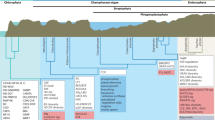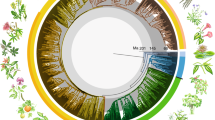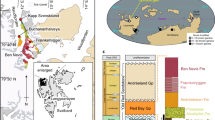Abstract
The origin and early evolution of land plants in the mid-Palaeozoic era, between about 480 and 360 million years ago, was an important event in the history of life, with far-reaching consequences for the evolution of terrestrial organisms and global environments. A recent surge of interest, catalysed by palaeobotanical discoveries and advances in the systematics of living plants, provides a revised perspective on the evolution of early land plants and suggests new directions for future research.
This is a preview of subscription content, access via your institution
Access options
Subscribe to this journal
Receive 51 print issues and online access
$199.00 per year
only $3.90 per issue
Buy this article
- Purchase on Springer Link
- Instant access to full article PDF
Prices may be subject to local taxes which are calculated during checkout





Similar content being viewed by others
References
Banks, H. P. Reclassification of Psilophyta. Taxon 24, 401–413 (1975).
Chaloner, W. G. & Sheerin, A. in The Devonian System(eds House, M. R., Scrutton, C. T. &Bassett, M. G.) 145–161 (The Palaeontological Association, London, (1979)).
Gray, J. Major Paleozoic land plant evolutionary bio-events. Palaeogeog. Palaeoclimatol. Palaeocol. 104, 153–169 (1993).
Graham, L. E. Origin of Land Plants(Wiley, New York, (1993)).
Mishler, B. D.et al. Phylogenetic relationships of the “green algae” and “bryophytes”. Ann. MO Bot. Gard. 81, 451–483 (1994).
Manhart, J. R. & Palmer, J. G. The gain of two chloroplast tRNA introns marks the green algal ancestors of land plants. Nature 345, 268–270 (1990).
Manhart, J. R. Phylogenetic analysis of green plant rbcL sequences. Mol. Phylogenet. Evol. 3, 114–127 (1994).
Raubeson, L. A. & Jansen, R. K. Chloroplast DNA evidence on the ancient evolutionary split in vascular land plants. Science 255, 1697–1699 (1992).
Chapman, R. L. & Buchheim, M. A. Ribosomal RNA gene sequences: analysis and significance in the phylogeny and taxonomy of green algae. Crit. Rev. Plant Sci. 10, 343–368 (1991).
McCourt, R. M., Karol, K. G., Guerlesquin, M. & Feist, M. Phylogeny of extant genera in the family Characeae (Charales, Charophyceae) based on rbcL sequences and morphology. Am. J. Bot. 83, 125–131 (1996).
Pryer, K. M., Smith, A. R. & Skog, J. E. Phylogenetic relationships of extant ferns based on evidence from morphology and rbcL sequences. Am. Fern J. 85, 205–282 (1995).
Kranz, H. D.et al. The origin of land plants: phylogenetic relationships among charophytes, bryophytes, and vascular plants inferred from complete small-subunit ribosomal RNA gene sequences. J. Mol. Evol. 41, 74–84 (1995).
Kranz, H. D. & Huss, V. A. R. Molecular evolution of pteridophytes and their relationships to seed plants: evidence from complete 18S rRNA gene sequences. Plant Syst. Evol. 202, 1–11 (1996).
Hiesel, R., von Haeseler, A. & Brennicke, A. Plant mitochondrial nucleic acid sequences as a tool for phylogenetic analysis. Proc. Natl Acad. Sci. USA 91, 634–638 (1994).
Edwards, D., Davies, K. L. & Axe, L. Avascular conducting strand in the early land plant Cooksonia. Nature 357, 683–685 (1992).
Edwards, D., Duckett, J. G. & Richardson, J. B. Hepatic characters in the earliest land plants. Nature 374, 635–636 (1995).
Fanning, U., Edwards, D. & Richardson, J. B. Adiverse assemblage of early land plants from the Lower Devonian of the Welsh Borderland. Bot. J. Linn. Soc. 109, 161–188 (1992).
Kenrick, P. Alternation of generations in land plants: new phylogenetic and morphological evidence. Biol. Rev. 69, 293–330 (1994).
Kenrick, P. & Crane, P. R. Water-conducting cells in early fossil land plants: implications for the early evolution of tracheophytes. Bot. Gaz. 152, 335–356 (1991).
Remy, W. Gensel, P. G. & Hass, H. The gametophyte generation of some early Devonian land plants. Int. J. Plant Sci. 154, 35–58 (1993).
Remy, W. & Hass, H. New information on gametophytes and sporophytes of Aglaophyton major and inferences about possible environmental adaptations. Rev. Palaeobot. Palynol. 90, 175–194 (1996).
Remy, W., Taylor, T. N., Hass, H. & Kerp, H. Four hundred-million-year-old vesicular arbuscular mycorrhizae. Proc. Nat Acad. Sci. USA 91, 11841–11843 (1994).
Stein, W. E., Harmon, G. D. & Hueber, F. M. in International Workshop on the Biology and Evolutionary Implications on Early Devonian Plants(Westfälische Wilhelms-Universität Münster, Germany, (1994)).
Taylor, T. N. & Osborne, J. M. The Importance of fungi in shaping the paleoecosystem. Rev. Palaeobot. Palynol. 90, 249–262 (1996).
Taylor, W. A. Ultrastructure of lower Paleozoic dyads from southern Ohio. Rev. Palaeobot. Palynol. 92, 269–280 (1996).
Kenrick, P. & Crane, P. R. The Origin and Early Diversification of Land Plants: A Cladistic Study(Smithsonian Institution Press, Washington DC, (1997)).
Gray, J. The microfossil record of early land plants: advances in understanding of early terrestrialization, 1970–1984 Phil. Trans. R. Soc. Lond. B 309, 167–195 (1985).
Gray, J. & Boucot, A. J. Early vascular land plants: proof and conjecture. Lethaia 10, 145–174 (1977).
DiMichele, W. A.et al.in Terrestrial Ecosystems Through Time: Evolutionary Paleoecology of Terrestrial Plants and Animals(ed. Behrensmeyer, A. K.) 205–325 (Univ. Chicago Press, (1992)).
Fanning, U., Richardson, J. B. & Edwards, D. in Pollen and Spores(eds Blackmore, S. &Barnes, S. H.) 25–47 (Clarendon, Oxford, (1991)).
Kroken, S. B., Graham, L. E. & Cook, M. E. Occurrence and evolutionary significance of resistant cell walls in charophytes and bryophytes. Am. J. Bot. 83, 1241–1254 (1996).
Wellman, C. H. & Richardson, J. B. Sporomorph assemblages from the ‘Lower Old Red Sandstone’ of Lorne, Scotland. Special Papers Palaeontol. 55, 41–101 (1996).
Edwards, D. in Palaeozoic Palaeogeography and Biogeography(eds McKerrow, W. S. &Scotese, C. R.) 233–242 (Geological Society, London, (1990)).
Morel, E., Edwards, D. & Iñiquez Rodriguez, M. The first record of Cooksonia from South America in the Silurian rocks of Bolivia. Geol. Mag. 132, 449–452 (1995).
Tims, J. D. & Chambers, T. C. Rhyniophytina and Trimerophytina from the early land flora of Victoria, Australia. Palaeontology 27, 265–279 (1984).
Cai, C. -Y., Dou, Y. -W. & Edwards, D. New observations on a Pridoli plant assemblage from north Xinjiang, northwest China, with comments on its evolutionary and palaeographical significance. Geol. Mag. 130, 155–170 (1993).
Hueber, F. M. Thoughts on the early lycopsids and zosterophylls. Ann. MO Bot. Gard. 79, 474–499 (1992).
Cai, C.et al. An early Silurian vascular plant. Nature 379, 592 ((1996)).
Geng, B. -Y. Anatomy and morphology of Pinnatiramosus, a new plant from the Middle Silurian (Wenlockian) of China. Acta Bot. Sin. 28, 664–670 (1986).
Raymond, A. & Metz, C. Laurussian land-plant diversity during the Silurian and Devonian: mass extinction, sampling bias, or both? Paleobiology 21, 74–91 (1995).
Edwards, D. & Davies, M. S. in Major evolutionary radiations(eds Taylor, P. D. &Larwood, G. P.) 351–376 (Clarendon, Oxford, (1990)).
Knoll, A. H., Niklas, K. J., Gensel, P. G. & Tiffney, B. H. Character diversification and patterns of evolution in early vascular plants. Paleobiology 10, 34–47 (1984).
Gensel, P. G. & Andrews, H. N. Plant Life in the Devonian(Praeger, New York, (1984)).
Taylor, T. N. & Taylor, E. L. The Biology and Evolution of Fossil Plants(Prentice Hall, New Jersey, (1993)).
Schweitzer, H. -J. Die Unterdevonflora des Rheinlandes. Palaeontographica B 189, 1–138 (1983).
Gerrienne, P. Inventaire des végétaux éodévoniens de Belgique. Ann. Soc. Géol. Belg. 116, 105–117 (1993).
Tappan, H. N. The Paleobiology of Plant Protists(Freeman, San Francisco, (1980)).
Raven, J. Plant responses to high O2concentrations: relevance to previous high O2episodes. Palaeogreg. Palaeoclimatol. Palaeocol. 97, 19–38 (1991).
Sztein, A. E., Cohen, J. D., Slovin, J. P. & Cooke, T. J. Auxin metabolism in representative land plants. Am. J. Bot. 82, 1514–1521 (1995).
Edwards, D. New insights into early land ecosystems: a glimpse of a Lilliputian world. Rev. Palaeobot. Palynol. 90, 159–174 (1996).
Edwards, D., Fanning, U. & Richardson, J. B. Stomata and sterome in early land plants. Nature 323, 438–440 (1986).
Raven, J. A. Comparative physiology of plant and arthropod land adaptation. Phil. Trans. R. Soc. Lond. B 309, 273–288 (1985).
Raven, J. A. The evolution of vascular plants in relation to quantitative functioning of dead water-conducting cells and stomata. Biol. Rev. 68, 337–363 (1993).
Niklas, K. J. Plant Allometry: The Scaling of Form and Process.(Univ. Chicago Press, (1994)).
Beerbower, R. in Geological Factors and the Evolution of Plants(ed. Tiffney, B. H.) 47–92 (Yale Univ. Press, New Haven, CT, (1985)).
Berner, R. A. GEOCARB II: a revised model of atmospheric CO2over Phanerozoic time. Am. J. Sci. 294, 56–91 (1994).
Mora, C. I., Driese, S. G. & Colarusso, L. A. Middle to Late Paleozoic atmospheric CO2levels from soil carbonate and organic matter. Science 271, 1105–1107 (1996).
Algeo, T. J., Berner, R., Maynard, J. B. & Scheckler, S. E. Late Devonian oceanic anoxic events and biotic crises: “rooted” in the evolution of vascular land plants? GSA Today 5, 45, 64–66 (1995).
Retallack, G. J. in Paleosols: their Recognition and Interpretation(ed. Wright, V. P.) (Blackwell, Oxford, (1986)).
Knoll, A. H. The early evolution of eukaryotes: a geological perspective. Science 256, 622–627 (1992).
Bengtson, S. (ed) Early life on Earth.(Columbia Univ. Press, New York, (1994)).
Taylor, T. N., Hass, H., Remy, W. & Kerp, H. The oldest fossil lichen. Nature 378, 244 (1995).
Hemsley, A. R. in Ultrastructure of Fossil Spores and Pollen(eds Kurmann, M. H. &Doyle, J. A.) 1–21 (Royal Botanic Gardens, Kew, (1994)).
Hueber, F. M. in International Workshop on the Biology and Evolutionary Implications of Early Devonian Plants(Westfälische Wilhelms-Universität, Münster, (1994)).
Simon, L., Bousquet, J., Léveque, C. & Lalonde, M. Origin and diversification of endomycorrhizal fungi with vascular plants. Nature 363, 67–69 (1993).
Selden, P. A. & Edwards, D. in Evolution and the Fossil Record(eds Allen, K. C. &Briggs, D. E. G.) 122–152 (Belhaven, London, (1989)).
Gray, J. & Shear, W. Early life on land. Am. Sci. 80, 444–456 (1992)).
Gray, J. & Boucot, A. J. Early Silurian nonmarine animal remains and the nature of the early continental ecosystem. Acta Palaeontol. Pol. 38, 303–328 (1994).
Retallack, G. J. & Feakes, C. R. Trace fossil evidence for Late Ordovician animals on land. Science 235, 61–63 (1987).
Scott, A. C., Stephenson, J. & Chaloner, W. G. Interaction and coevolution of plants and arthropods during the Palaeozoic and Mesozoic. Phil. Trans. R. Soc. Lond. B 336, 129–165 (1992).
Banks, H. P. & Colthart, B. J. Plant-animal-fungal interactions in early Devonian trimerophytes from Gaspé, Canada. Am. J. Bot. 80, 992–1001 (1993).
Edwards, D., Seldon, P. A., Richardson, J. B. & Axe, L. Coprolites as evidence for plant-animal interaction in Siluro-Devonian terrestrial ecosystems. Nature 377, 329–331 (1995).
Allen, J. R. L. Marine to fresh water: the sedimentology of the interrupted environmental transition (Ludlow-Siegenian) in the Anglo-Welsh region. Phil. Trans. R. Soc. Lond. B 309, 85–104 (1985).
Melkonian, M. & Surek, B. Phylogeny of the Chlorophyta: congruence between ultrastructural and molecular evidence. Bull. Soc. Zool. Fr. 120, 191–208 (1995).
Bremer, K., Humphries, C. J., Mishler, B. D. & Churchill, S. P. On cladistic relationships in green plants. Taxon 36, 339–349 (1987).
Garbary, D. J., Renzaglia, K. S. & Duckett, J. G. The phylogeny of land plants: a cladistic analysis based on male gametogenesis. Plant Syst. Evol. 188, 237–269 (1993).
Capesius, I. Amolecular phylogeny of bryophytes based on the nuclear encoded 18S rRNA genes. J. Plant Physiol. 146, 59–63 (1995).
Taylor, T. N. The origin of land plants: some answers, more questions. Taxon 37, 805–833 (1988).
Rothwell, G. W. in Pteridiology in Perspective(eds Camus, J. M., Gibby, M. &Johns, R. J.) (Royal Botanic Gardens, Kew) (in the press).
Albert, V. A.et al. Functional constraints and rbcL evidence for land plant phylogeny. Ann. MO Bot. Gard. 81, 534–567 (1994).
Edwards, D., Fanning, U. & Richardson, J. B. Lower Devonian coalified sporangia from Shropshire: Salopella Edwards &Richardson and >Tortilicaulis Edwards. Bot. J. Linn. Soc. 116, 89–110 (1994).
Bateman, R. M., DiMichele, W. A. & Willard, D. A. Experimental cladistic analysis of anatomically preserved lycopsids from the Carboniferous of Euramerica: an essay on paleobotanical phylogenetics. Ann. MO Bot. Gard. 79, 500–559 (1992).
Feist, M. & Grambast-Fesssard, N. in Calcareous Algae and Stromatolites(ed. Riding, R.) 189–203 (Springer, Berlin, (1991)).
Hébant, C. in Bryophyte Systematics(eds Clarke, G. C. S. &Duckett, J. G.) 365–383 (Academic, London, (1979)).
Acknowledgements
We thank W. G. Chaloner, D. Edwards, J. A. Raven, P. S. Herendeen, E. M. Friis, S. Bengtson and especially J. Gray for criticisms of earlier drafts of this manuscript; W. Burger, J. Cattel, A. N. Drinnan, M. Feist, L. E. Graham, H. Haas, H. Kerp, W. A. Taylor and P. Lidmark for assistance with illustrations. This work was supported in part by the Swedish Natural Science Research Council (NFR) and the National Science Foundation.
Author information
Authors and Affiliations
Rights and permissions
About this article
Cite this article
Kenrick, P., Crane, P. The origin and early evolution of plants on land. Nature 389, 33–39 (1997). https://doi.org/10.1038/37918
Issue Date:
DOI: https://doi.org/10.1038/37918
This article is cited by
-
Salicylic acid enhances cell growth, fatty acid and astaxanthin production in heterotrophic Chromochloris zofingiensis without reactive oxygen species elevation
Biotechnology for Biofuels and Bioproducts (2024)
-
Cellulose nanofiber/bio-polycarbonate composites as a transparent glazing material for carbon sequestration
Cellulose (2024)
-
Regional assessment of diversity and distribution of native tree species in South Asia
Biodiversity and Conservation (2024)
-
Protocol: an improved method for inducing sporophyte generation in the model moss Physcomitrium patens under nitrogen starvation
Plant Methods (2023)
-
Characterization and expression profiles of the B-box gene family during plant growth and under low-nitrogen stress in Saccharum
BMC Genomics (2023)
Comments
By submitting a comment you agree to abide by our Terms and Community Guidelines. If you find something abusive or that does not comply with our terms or guidelines please flag it as inappropriate.



